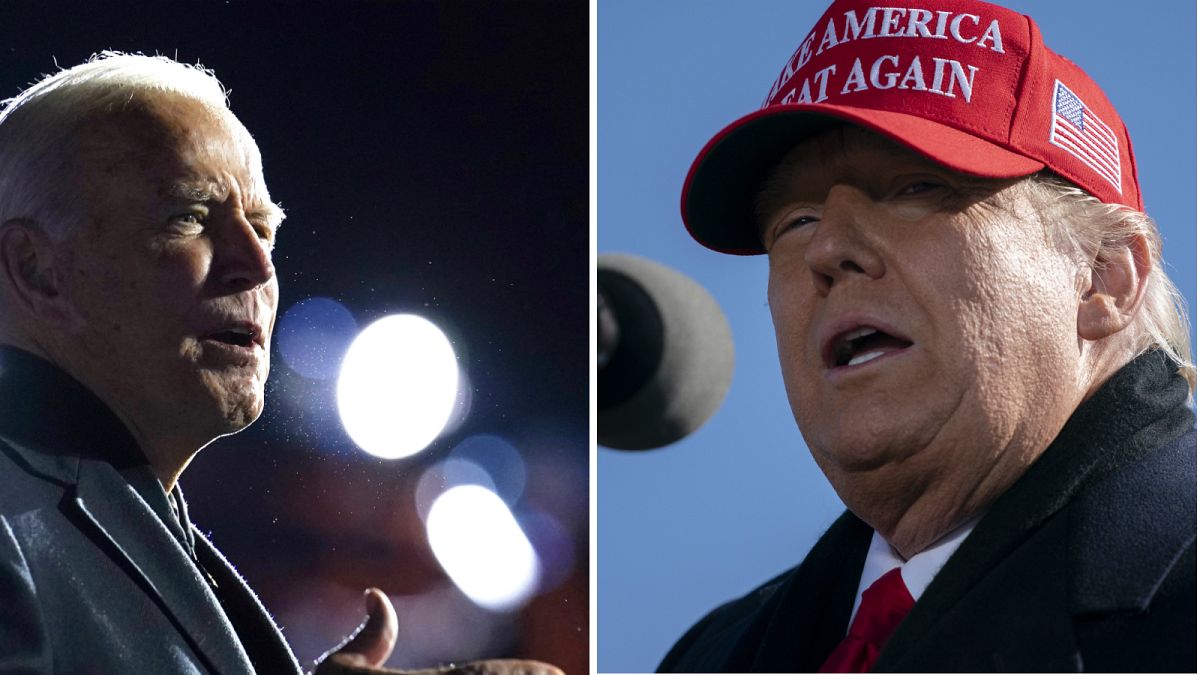Latest forecasts place Donald Trump firmly as the underdog.
Donald Trump's path to power appears more difficult than that of rival Joe Biden, according to latest forecasts.
Data analysis forecaster FiveThirtyEight, which was founded by statistician Nate Silver, said there was now a 90% chance of the former vice president winning the vote.
The site, which has made predictions in previous elections, analyses state and national polling results, along with other factors, and has run 40,000 simulations of the election to calculate the probability of each side winning.
As of Monday, this stands at a 90% chance for Biden and just 10% for Trump.
A path to power for the current US president is now looking like a defence strategy of the battleground states he won in 2016, including the traditionally Republican Georgia and Arizona.
His hopes are also pinned on the swing states of Florida and Pennsylvania.
Biden's potential path to power
Win back Hillary Clinton's losses
In 2016, the then Democrat candidate Hillary Clinton lost Michigan, Pennsylvania and Wisconsin - three states that had previously shown long-time support for her party.
This means that if Biden manages to maintain support in all of Clinton's previously secured states, along with clawing back these three losses, he would secure 279 electoral votes, and would be nine votes over a necessary 270 threshold.
Biden has spent around 30% of his advertising spending in these three key states since June, although all eyes will be on Pennsylvania for the ultimate power struggle.
He is currently polling with a slight advantage over Trump in Pennsylvania, where he has the birth card to play, having been born in Scranton.
However, Trump has recently seen his chances for a win increase after Biden said he wanted to phase out fossil fuels - although without going as far to say he would ban fracking.
But what if Biden misses out on Pennsylvania?
Without the 20 electoral votes offered by Pennsylvania, Biden would need to find another 11 to reach the magic 270.
These extra votes may well be found, then, in Arizona (11 votes) or in North Carolina (15 votes), where Trump won in the last election, but with small margins.
Arizona is traditionally a Republican state and hasn't had a Democrat in charge since 1996, but in the last election saw Trump win by 3.5 percentage points - the smallest margin in two decades.
In North Carolina, meanwhile, sights are set on the university-educated newcomers to help push the state over the line.
Barack Obama was the first Democrat candidate to win there in 2008, and while he narrowly lost in 2012, along with Clinton losing again in 2016, this would be a tight win for Biden, but still a possible one.
A combination of the above
Should Biden win back Clinton's losses in Michigan, Pennsylvania and Wisconsin - and also take either Arizona or North Carolina, his overall victory would be a comfortable one.
Other states capturing Biden's eye include Ohio, Iowa and Georgia, while Democrats hope the state of Texas may finally be in reach.
The swing state of Florida, which is offering up 29 electoral votes, is also promising a close race between the pair.
"Biden has more of an opportunity to win by a larger electoral number than Trump does," according to Republican pollster Glen Bolger.
"It doesn't mean Trump can't win."
Trump's potential path to power
Major hopes on Florida
To win 270 electoral votes, Trump will likely need to secure a win in Florida, which we have already noted is going to be a tight race.
This has resulted in the president focusing much of his campaigning this month in the state, where he and his wife Melania moved to last year.
He is also planning to accompany the first lady when she votes near Palm Beach County tomorrow.
Pennsylvania
This, as mentioned, is going to be a huge battleground for the nominees, and Trump is looking to Pennsylvania as being his best chance of getting to the 270 electoral votes.
He has held seven rallies this week - including four on Saturday alone - in the state, which highlights the importance of this area for getting re-elected.
Trump has also jumped on Biden's perceived weakness when revealing his plan to phase out fossil fuels, saying last week: "Will cripple our nation and send us into an absolute depression".
Will Florida and Pennsylvania wins be enough for Trump?
The short answer is no: not if he doesn't win the majority of states he secured back in 2016.
Even with a win in Ohio, the president would need to also maintain his 2016 victories along with others he lost and some he is consistently trailing in the polls.
This would also mean he may have to focus on flipping Minnesota, Nevada and New Hampshire - something that is unlikely.
Therefore, Trump's path to re-election is looking much tighter compared to his rival and has led to a defence strategy with grasping for every vote he can.
This can be seen with his holding of rallies in places like Maine and Nebraska - most notably in Omaha, Nebraska, which is a metropolitan district worth a single electoral vote.


